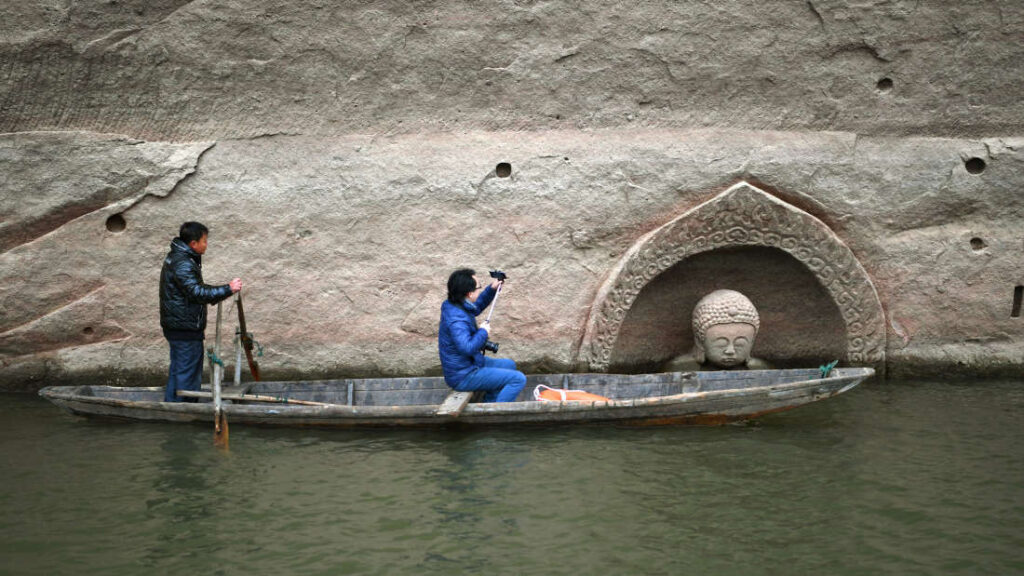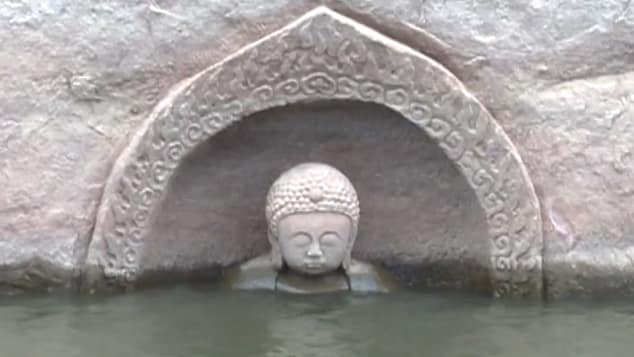600-Year-Old Buddha Statue Discovered In China As Reservoir Water Level Drops
Lower water levels in a village in eastern China led to a shocking discovery the other day. What was discovered was an approximately 600-year-old Buddha statue almost perfectly preserved.

The statue was discovered at Hongmen Reservoir in the Nancheng county of Jiangsu Province. It is in this location that a nearby hydropower gate is under renovation, which led to the drop in water levels by nearly 33 feet or 10 meters.
Sitting against a cliff, the statue appears to be watching over the remaining body of water. Many locals believe it to be an auspicious sign. It might be so much more than just a statue though, archaeologists believe it could just be the tip of a buried treasure trove.
According to local history records, the reservoir may be located on the ruins of Xiaoshi – an ancient settlement. It’s likely that this large Buddha, which stands a whopping 3.8 meters (12.5 feet) tall, was the centerpiece of the village.
The statue itself is still surprisingly detailed given how old it is. It is estimated to be around 600-years-old dating back to early the Ming Dynasty (1368-1644) but could go back as far as the Yuan Dynasty, making it even older.
So how is this possible? Well, Xu Changqing, director of the Research Institute of Archaeology of Jiangxi province, has stated that being submerged underwater has acted as a preserving agent. If it was exposed, it probably would have suffered weathering or oxidation damage but it’s almost perfectly preserved with the same detail that it would have had the day it was done.
The natural preservation isn’t just the remarkable thing about this statue, the fact that is also survived the country’s Cultural Revolution in the 1960s when people were told to get rid of everything old, feudalistic and superstitious is also quite amazing.
According to Guan Zhiyong, a local official, this miraculously preserved Buddha statue was built by ancient people as a spiritual protector to calm the rapid-flowing current where two rivers converge.
When the Hongmen reservoir was built back in 1960, the statue was submerged. Local authorities were not aware of heritage protection at that time so the statue was completely ignored.
Today, however, the statue will be fully protected and once excavated, is likely to be placed in a museum for all to see in its full glory.
It’s already stirred up old feelings with Huang Keeping, an 82-year-old local blacksmith who said he first saw the Buddha back in 1952. There’s no doubt it will be bringing back lots of nostalgia for many others too.

As investigations continue into both the Buddha statue, as well as the ancient settlement, there’s not much more than can be done.
Authorities are currently working on removal as well as preservation plan for the statue. For now, though, the best place for it is under the water! It’s lasted for over half a millennium so it can definitely last another few years until it’s possible to safely remove it. Until such a time, it’s possible to admire it from afar with all the photographs and videos that have been posted online.
China is home to several spectacular Buddha statues, not least this hidden one. Alongside this centuries-old wonder, China offers incredible Buddhist cliff and cave carvings such as the famous Leshan Giant Buddha, which is the world’s tallest Buddha statue.






